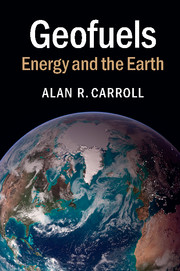Book contents
- Frontmatter
- Contents
- Acknowledgments
- 1 Introduction
- 2 The Living Earth
- 3 Warmed from Above: Solar Energy
- 4 Wind, Water, and Waves: Energy from the Fluid Earth
- 5 Covered in Green: Biofuels Basics
- 6 Fossil Farming: The Geologic Underpinnings of Biofuels
- 7 The Light of an Ancient Sun: Fossil Fuel Origins
- 8 Digging for Daylight: Coal and Oil Shale
- 9 Skimming the Cream: Conventional Oil and Gas
- 10 Stuck in the Mud: Fossil Fuels That Fail to Flow
- 11 Petrified Petroleum: Oil Sand and Gas Hydrate
- 12 Water, Water, Everywhere
- 13 Primordial Power: Geothermal and Nuclear
- 14 Out of Sight, Out of Mind: Geologic Waste Disposal
- 15 How Long Is Forever? Energy and Time
- 16 Conclusions
- Index
- References
10 - Stuck in the Mud: Fossil Fuels That Fail to Flow
Published online by Cambridge University Press: 05 March 2015
- Frontmatter
- Contents
- Acknowledgments
- 1 Introduction
- 2 The Living Earth
- 3 Warmed from Above: Solar Energy
- 4 Wind, Water, and Waves: Energy from the Fluid Earth
- 5 Covered in Green: Biofuels Basics
- 6 Fossil Farming: The Geologic Underpinnings of Biofuels
- 7 The Light of an Ancient Sun: Fossil Fuel Origins
- 8 Digging for Daylight: Coal and Oil Shale
- 9 Skimming the Cream: Conventional Oil and Gas
- 10 Stuck in the Mud: Fossil Fuels That Fail to Flow
- 11 Petrified Petroleum: Oil Sand and Gas Hydrate
- 12 Water, Water, Everywhere
- 13 Primordial Power: Geothermal and Nuclear
- 14 Out of Sight, Out of Mind: Geologic Waste Disposal
- 15 How Long Is Forever? Energy and Time
- 16 Conclusions
- Index
- References
Summary
The oil and gas deposits that powered the 20th century can be elegantly summarized in a single word: mobility. Fluid hydrocarbons move freely through rock layers beneath the Earth's surface and under the right conditions can travel long distances to natural traps. Once trapped they readily flow to a well bore, making oil and gas relatively easy to transport to the surface. They can then be pumped across continents through pipelines or carried across the globe on tanker ships. Refined products flow easily though internal combustion engines, which have in turn revolutionized human mobility across the land, sea, or air.
The mobility of fluid hydrocarbons might be compared to vehicular traffic on a system of interstate highways or motorways. Just as high-speed roads transport people quickly between cities, certain porous and permeable rock types allow oil and gas to flow quickly (in geologic terms) toward underground traps. But what if there were no such subterranean superhighways? Or alternatively, what if the oil were simply too thick and sluggish to accelerate to highway speeds? Fluid hydrocarbons might then be forced to travel instead on the geologic equivalent of country lanes, gravel tracks, and muddy back roads, perhaps never reaching their destination at all.
In fact, much of the oil and natural gas that has been generated from source rocks in the Earth's crust has never moved very far. Some of it is retained within the source rocks themselves, which constitute less permeable, organic-rich mudstone, and some has migrated tens to hundreds of meters into adjacent beds that are only slightly more permeable. The relative immobility of such hydrocarbons means they do not become highly concentrated in localized traps; instead they remain spread out across large areas of sedimentary basins, just as coal is spread out across the Powder River Basin (see Chapter 8).
The U.S. Geological Survey describes these immobile oil and gas accumulations as “continuous,” because of the observation that they lack the well-defined spatial boundaries imposed by conventional petroleum traps (see Chapter 9).
- Type
- Chapter
- Information
- GeofuelsEnergy and the Earth, pp. 189 - 214Publisher: Cambridge University PressPrint publication year: 2015

